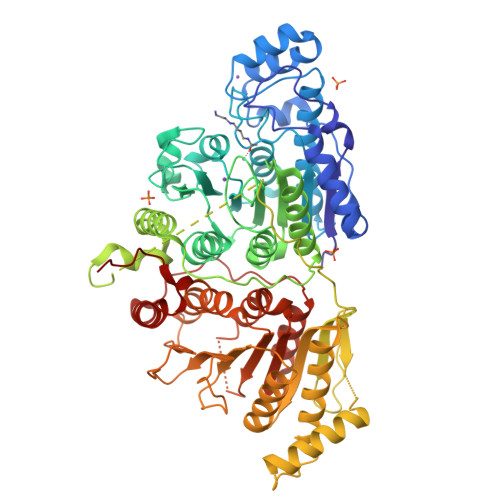X-ray Crystallographic Snapshots of Substrate Binding in the Active Site of Histone Deacetylase 10.
Herbst-Gervasoni, C.J., Christianson, D.W.(2021) Biochemistry 60: 303-313
- PubMed: 33449614
- DOI: https://doi.org/10.1021/acs.biochem.0c00936
- Primary Citation of Related Structures:
7KUQ, 7KUR, 7KUS, 7KUT, 7KUV - PubMed Abstract:
Histone deacetylase 10 (HDAC10) is a zinc-dependent polyamine deacetylase enriched in the cytosol of eukaryotic cells. The active site of HDAC10 contains catalytic residues conserved in other HDAC isozymes that function as lysine deacetylases: Y307 assists the zinc ion in polarizing the substrate carbonyl for nucleophilic attack, and the H136-H137 dyad serves general base-general acid functions. As an inducer of autophagy, HDAC10 is an attractive target for the design of selective inhibitors that may be useful in cancer chemotherapy. Because detailed structural information regarding the catalytic mechanism of HDAC10 may inform new approaches to inhibitor design, we now report X-ray crystal structures of HDAC10 in which reaction intermediates with substrates N 8 -acetylspermidine and N -acetylputrescine are trapped in the active site. The Y307F substitution prevents activation of the substrate carbonyl for nucleophilic attack by the zinc-bound water molecule, thereby enabling crystallographic isolation of intact enzyme-substrate complexes. The H137A substitution removes the catalytically obligatory general acid, thereby enabling crystallographic isolation of oxyanionic tetrahedral intermediates. Finally, the acetate complex with the wild-type enzyme represents a product complex after dissociation of the polyamine coproduct. Taken together, these structures provide snapshots of the reaction coordinate of acetylpolyamine hydrolysis and are consistent with a mechanism in which tandem histidine residues H136 and H137 serve as general base and general acid catalysts, respectively. The function of the histidine dyad in the HDAC10 mechanism appears to be similar to that in HDAC6, but not HDAC8 in which both functions are served by the second histidine of the tandem pair.
Organizational Affiliation:
Roy and Diana Vagelos Laboratories, Department of Chemistry, University of Pennsylvania, Philadelphia, Pennsylvania 19104-6323, United States.





















